Natural light can shape the entire atmosphere of a space—brightening interiors, reducing energy consumption, and enhancing visual comfort. The way daylight enters a building depends on a variety of design decisions, but none are more critical than the selection of sealed units. Glass is no longer a passive element in architecture; with the right configuration, it becomes a dynamic tool to optimize light transmission, regulate solar gain, and balance interior temperatures.
While aesthetic goals often drive decisions around window sizing and placement, performance outcomes—such as glare reduction, heat retention, and daylight diffusion—are heavily influenced by the composition of the sealed units themselves. From Low-E coatings to frame ratios, every component plays a role in how light is harnessed and how thermal comfort is maintained year-round.
Glass Type in Sealed Units Shapes Daylight Strategy
Choosing the right glass within sealed units is one of the first and most impactful decisions in daylighting design. Each glass type interacts with light and heat differently, and performance requirements often depend on location, orientation, and project goals.
Clear Float Glass allows the highest visible light transmittance (VLT), making it ideal for spaces where maximum natural light is desired. However, it lacks solar control, so it’s best used in shaded or north-facing applications.
Tinted Glass can help soften glare and reduce solar heat gain, but it also reduces visible light. Tints in grey, bronze, or green hues can enhance aesthetics while limiting overheating in exposed façades.
Low-E (Low Emissivity) Glass is the modern standard for balancing daylight with energy performance. It reflects infrared heat while allowing visible light to pass through. Depending on the coating (hard coat vs. soft coat), Low-E glass can prioritize solar gain or solar control.
The glass configuration inside a sealed unit ultimately determines how daylight will perform indoors—whether it will flood a space or gently diffuse.
How Coatings in Sealed Units Affect Solar Gain
Glass coatings are invisible layers applied during or after production to influence the glass’s ability to reflect or absorb heat. Within sealed units, the position and type of coating significantly affect solar heat gain and interior temperature regulation.

High Solar Gain Low-E Coatings are ideal for colder climates, where capturing solar warmth reduces heating demand. They work best in south-facing façades that receive full winter sun.
Low Solar Gain Coatings, on the other hand, block a significant portion of infrared radiation. These coatings are optimal in warmer regions or in spaces where air conditioning loads need to be minimized.
Soft Coat Low-E Glass offers the best thermal performance but requires sealed units for protection from corrosion. It’s a top choice for residential and high-performance commercial projects.
Hard Coat Low-E Glass is more durable and better suited to exposed applications, such as storm panels or single glazing. It typically has slightly higher solar heat gain, which can be beneficial in passive solar designs.
Strategically selecting coated sealed units allows for fine-tuning solar gain, especially when paired with climate-specific design intent.
Orientation and Glazing Ratio Impact Daylighting Effectiveness
While sealed units provide the technical foundation for light and heat control, how they are positioned and proportioned within the building envelope defines their real-world performance.
Orientation determines when and how much direct sunlight a window will receive. South-facing windows can be optimized for winter heating. East- and west-facing elevations are prone to glare and heat buildup due to low-angle sunlight, making them ideal candidates for Low-E sealed units with solar control properties.
Glazing-to-Wall Ratio also influences both the quantity and quality of natural light. Too much glass can lead to overexposure and heat loss; too little reduces daylight penetration and underutilizes views.
Frame-to-Glass Ratio further affects visible light entry. Slimline framing systems allow sealed units to dominate the surface area, maximizing daylight while minimizing visual obstruction. Pairing narrow frames with high-performance sealed units enables designers to deliver large glass spans without sacrificing energy efficiency.
Regional Climate Drives Performance Priorities
Sealed units must be specified with local climate conditions in mind. In colder zones, sealed units with high R-values and moderate solar gain can contribute to passive heating strategies. In hotter regions, high-performance coatings that reduce solar heat gain without darkening the glass are critical.
In mixed climates, dual-glazed sealed units with selective Low-E coatings can provide both winter insulation and summer protection. Adding inert gas fills like argon further improves thermal insulation without affecting light transmission.

Designers should look beyond appearance and ensure that sealed units are matched to performance metrics based on real temperature swings, sun angles, and building orientation. A single unit specified without context can result in occupant discomfort or energy inefficiency over time.
Configuring Sealed Units for Both Aesthetics and Efficiency
Sealed units offer nearly endless design flexibility, allowing for dual-pane, triple-pane, and even decorative configurations that enhance both appearance and performance.
Triple-Pane Sealed Units deliver excellent thermal insulation and condensation resistance, especially useful in northern climates or large glazed façades.
Low-Iron Glass options within sealed units offer maximum clarity and color neutrality, ideal for luxury homes, showrooms, or public-facing façades where visual purity is paramount.
Integrated Grilles and Decorative Glass can be included in sealed units without affecting the core performance, providing visual interest for residential or boutique commercial projects.
The key is to approach sealed units not as a commodity, but as a custom-engineered component that supports the building’s energy goals and enhances visual comfort.
High-Performance Daylighting Starts with Smarter Glass Decisions
Bringing natural light into a space is about more than just adding windows. It’s a thoughtful collaboration between design intent, environmental control, and product performance. Selecting the right sealed units is central to this process. The wrong configuration can lead to overheating, glare, and energy waste. The right one can elevate a space, making it feel larger, brighter, and more comfortable all year round.
At Insul-Lite Manufacturing™, we engineer and supply custom sealed units designed to meet the highest daylighting and energy-efficiency standards. Whether you’re building a passive home, a modern office, or a mixed-use tower, our sealed units offer the flexibility, performance, and visual clarity needed to bring your design to life, without compromise.
Contact us today to learn how our sealed units can help optimize natural light and thermal comfort in your next project.





